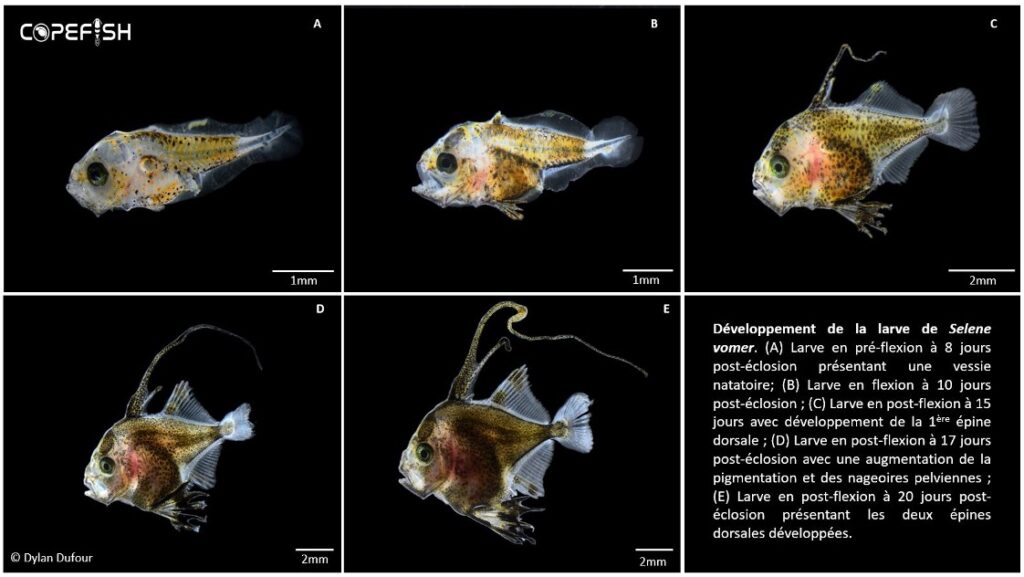It’s not really in demand as an aquarium fish, but nevertheless the glimmering silver Lookdown, Selene vomer, is a very common game fish displayed in large public aquariums. It’s also not the first time this fish has been captive bred, but the interesting part is that the French aquaculture venture Nausicaa is doing it in a multi-species larval rearing system, which seems to a trend at the moment. Breeding several species in the same tank reduces cost, but a careful protocol must be followed to avoid competition or predation.
Since 2011, Nausicaá, together with Lille university, created the project Copefish. The research team led by Professor Sami Souissi, a researcher in the Laboratory of Oceanology and Geosciences in Wimereux, near Lille, France. The team specializes in aquaculture, and in particular in the culture of marine plankton, used as live prey for early larval stages of many marine species.
A Huge Broodstock Aquarium

The biggest public aquarium in Europe, with 10,000 million liters (2,600,000 US gal) and with its perfectly fed fishes, is a perfect broodstock holding system, and a lot of eggs can be collected regularly. Among the 52 species present in the basin, a multitude of individuals reproduce there naturally, including Selene vomer (sometimes called the Look Down Trevally). This species belongs to the Carangidae family and is distributed in the Western Atlantic, along the American coast, from Maine to the Gulf of Mexico, and south to the coast of Uruguay. Selene vomer is, in part, a gamefish and commercial fish, but also an ornamental species in various public aquariums worldwide. At Nausicaá, 600 potential broodstock spawners (Fig.1.A) are present in the main tank. Reproduction takes place in open water, the larvae are planktonic, then the juveniles meet close to the surface (Fig.1. B, C).
A Multitude of Prey Types
At the French facilities, eggs are collected using a plankton net and then incubated at a temperature of 25.8 (+/- 0.5) °C (approximately 78ºF) in the dark until hatching in water with a salinity of 35 ppt. At this temperature, the eggs hatch after about 24 hours of incubation. Live copepod nauplii (Fig.2. A) ranging in size from 50 to 90 μm are then provided to ensure the presence of food when the mouth of the larvae is formed. On the 6th day of rearing, live adult copepods such as Parvocalanus crassirostris (Fig.2. B) and Acartia tonsa, as well as Brachinous plicatilis rotifers are distributed. On the 15th day, the rotifers are replaced by Artemia salina nauplii until weaning on the 50th day.

Copepods, constituting the major part of natural zooplankton, represent the main source of food for larval fish in the marine environment. Their nutritional quality and their size are essential for the growth and proper development of fish larvae. Their integration into the diet at the right time and in sufficient quantity is one of the secrets of the success of this larval rearing.
A Very Interesting Fish with a Very Interesting Larva
Selene vomer is an interesting species from the morphological point of view. On the 10th day of rearing, pelvic fins appear, followed by two long fin dorsal spines (Fig. 3: C, D, E) which can measure up to 4 times the total length of the larva.

The metamorphosis (from the post-larvae stage to the juvenile stage) takes place on the 17th day of rearing. At this stage, more intense hunting behaviors and gregarious behavior can be observed.
Multi-species Larvae Rearing
The captive breeding of Selene vomer adds to the list of species successfully bred in captivity in Nausicaá as part of the COPEFISH project. During this documented rearing effort, 100 Selene vomer
(Lookdown), 53 Trachinotus goodei (Palometa) and 328 Haemulon sp. (Grunt) have been brought through metamorphosis.
Interspecific relationships such as predation and competition (for food for example) can be observed during larval development. The research team, therefore, adapts their protocols according to what is spawning in order to raise several species at the same time. A few months earlier, the team had succeeded in breeding 103 Gnathanodon speciosus (Golden Trevally), 48 Lutjanus kasmira (Bluestriped snapper), 20 Harengula clupeola (Scaly Herring), and 10 Haemulon flavolineatum (Yellow Grunt).
References
Reproduction et suivi du développement larvaire de la Selene vomer à Nausicaá
dans le cadre du projet COPEFISH.
Dylan Dufour1, Axelle Cresson1, Ludwig Coulier2, Dominique Mallevoy2, Sami Souissi1*
1 Université de Lille – LOG- Laboratoire d’Océanologie et de Géosciences, UMR CNRS-ULille-ULCO-IRD, Wimereux, France,
2 Nausicaá – Centre national de la Mer, Boulogne sur Mer, France.



